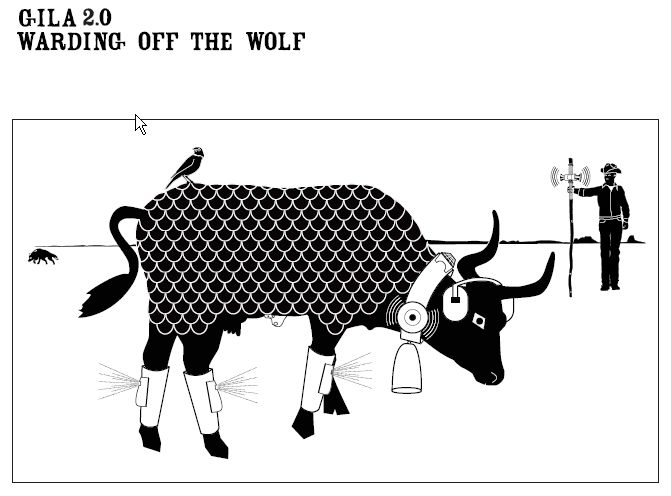23
Nov
In the News: ISEA Artists Explore Intersections of Nature and Technology

BY MEGAN KAMERICK
So exactly what kind of sound might stop a Mexican Grey Wolf from taking down a cow?
That’s just one of the questions explored by the International Symposium on Electronic Arts. Albuquerque recently hosted ISEA,bringing top international artists for performances, lectures and art installations. It’s the first time the event has been in the U.S. since 2006.
Exhibits created as part of ISEA will be here through early January at 516 ARTS and the Albuquerque Museum and many of the pieces tackle hot-button issues like water, climate change and the interactions between humans and nature.
Artist Marina Zurkow and collaborator Christie Leece take technology to a ridiculous extreme with “GIla 2.0: Warning Off the Wolf.”
It includes a decorative collar that issues noises like gargling, elephants and singing cowboys. Zurkow is a New Yorker who did a residency in Silver City as part of ISEA. The piece at 516 ARTS proposes — maybe — arming cattle to fend off wolves. Zurkow says she tested the sounds out with a predator specialist in Utah.
“He said ‘It’s great. Just keep it really weird. As long as it’s novel and unpredictable, animals don’t get used to it and they actually can’t stand human sound,'” she says.
The ISEA 2012 theme is “Machine Wilderness.” The idea is to re-envision how art, technology and nature can interact and riff off one another. It’s a perfect fit for New Mexico, says Andrea Polli, ISEA 2012’s artistic director. New Mexico has some of the most wild places in the country, she says, and some of the most advanced science as well.
“It’s a perfect place for that clash and juxtaposition of nature and technology,” Polli says.
Zurkow imagines a cow with body armor and leg guards that spray scents wolves hate, like citronella and human urine. An electronic cowbird perches on the bovine’s rump, ready to set off an alarm and warn ranchers of predators via Twitter.
People have been experimenting with technology around the world to protect livestock. So is Zurkow serious? Maybe. Maybe not. But she says the questions underlying the piece are very real: What do public lands mean? Who gets to use them?
“¦
Artists are good at upending the relationships between humans and nature, says Greg Esser. He’s the director of the Desert Initiative, a collaboration launched at ISEA of more than 30 cultural organizations, universities and public agencies in the Southwest.
“Artists are particularly trained in ways of critical thinking and creative thinking that directly challenge our assumptions and really push us to think or look at things in new ways,” Esser says. “So I think they are uniquely positioned to help us find solutions that might be obvious but that no one has thought of yet.”
Considering how difficult it is to talk about issues like climate change or water, maybe artists like those in ISEA can foster new discussions about our collective future.
*****
Click here to read the full story. There is also a link to listen to the radio broadcast of this story.
If you are in the Albuquerque area be sure to check out the Machine Wilderness exhibit at the museum. On display through January 6, 2013. Click here for more information.
Artwork of Marina Zurkow, New Mexico Wilderness Alliance.



